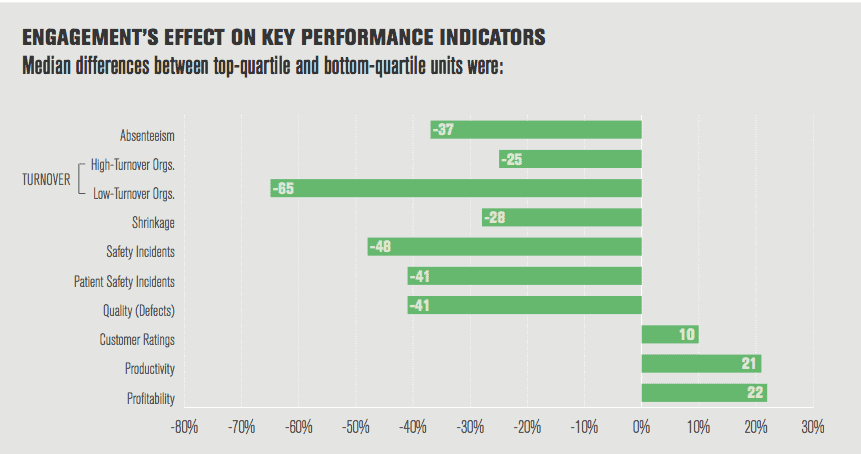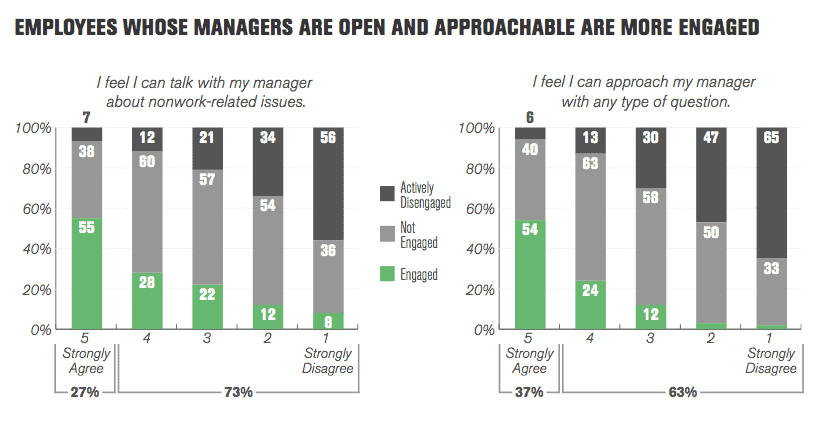If your one to one meetings aren't going well, deep down, you probably know it. Some (or all) of the following are probably true then:
- Empty talk: Meetings are filled with idle chatter or work projects, without talking about any issues important to them.
- Bare minimum answers: When you ask questions your team member freezes up and avoids the questions or gives simple, yes or no answers.
- Broken records: You talk in circles, often covering the same topic repeatedly with no progress made.
- Cut short: You both dread the meeting and look for the first chance to end it, even if it's only been 5 or 10 minutes.
- Poor body language: Your team member takes a defensive posture in the meeting: crossing their arms, placing objects between you and them, sitting far away from you, leaning back, avoiding eye contact, etc.
Any one of those can make one to one meetings feel wasted for you and your team member, but a combination of many of them is deadly. I'm feeling dread just thinking about them.
Done right, a one to one meeting with each of your team members can be great. Done wrong, they can be filled with awkward silences, team members dodging your questions, or empty small talk to fill the time. Don't let this be the story of your one to ones. You'll miss out on a valuable investment in the morale and motivation of your team.
The true cost of a bad one to one meeting
There's a good chance someone disengaged in your one to one meetings is also not doing well at work. Disengagement can manifest itself in lower performance or simply not showing the extra initiative they used to. A lack of engagement affects every aspect of their work. When your team is not engaged, these are the benefits you're missing out on:

Beyond their work, they may also be quietly looking for a new job, which if they get an offer, it will be too late to do anything. As a story I recently heard went:
"My boss had cancelled a series of my one on ones in a row, despite clearly seeing I was frustrated in a number of situations.
By the time we finally met, I was already interviewing, and a few days later I was signing an offer letter for a new job."
Don't be that manager. Your one to one is your best way to avoid voluntary turnover on your team.
Table of Contents:

How to turn around your one to one meeting
Knowing that these meetings are so important, and that you might be having problems with some of your team because your one to ones aren't going well, let's talk about how you can fix them.
This starts by looking at the common symptoms of bad one on ones. What is it that causes people to freeze up, shut down, and dread these meetings?
1) Cause #1: Making your one to one meeting a Status Update
There are few things as damaging as making your one to ones a status update. They work the other 39+ hours a week for you on projects. This meeting is about them, not their work tasks for you. As former CEO and cofounder of Intel, Andy Grove wrote:
"The most important criterion governing matters to be talked about [in one-on-ones] is that they be issues that preoccupy and nag the subordinate.”
When you make your one to one meeting a status update, it squeezes out the time for you to talk about everything else you should cover in a one to one. It also can make other topics elephants in the room; it's easier to talk about a project and tasks than it is to talking hard discussions about being unhappy in your role or giving critical feedback. When you only have 30-60 minutes every week or two for each person, letting status updates fill the time is a huge waste.
Not convinced? You can learn more about why Status Updates don't fit in one to one meetings here.
2) Cause #2: Lack of follow through
When your team member brings up something with you in a one to one, it's important to them. That means you need to not just talk about problems and feedback they bring to you, but what can be done about it. If you don't take even a small action on what they come to your with, they will stop bringing them up, even though the problem hasn't gone away. As Ben Horowitz, VC at A16Z and former CEO, wrote about his mentor, Bill Campbell:
"I call this characteristic the Bill Campbell attribute after my friend Bill who is the best that I've ever seen at this...When you talk to Bill, you get the feeling that he cares deeply about you and what you have to say, because he does. And all of that shows up in his actions and follow through."
When a manager doesn't follow through, it signifies to the team member that either what they bring up isn't important, or they aren't important to the manager. When that happens it's easy for team members to think things like, "What's the point?" or "They don't care..." Both are lethal for a manager. Trust is the foundation of great leadership and it depends on you keeping your promises. You show you care about them and their well-being in your words and actions.
3) Cause #3: Weak discussion topics
If you spend your one to one meeting talking about status updates, random gossip, or small talk, it shouldn't be surprising if neither you nor your team member find the meetings valuable. Anyone can find ways to talk randomly for 10-20 minutes to fill the time. But that's not what one to one meetings are about. As Ben Horowitz wrote:
"While it's not the manager's job to set the agenda or do the talking, the manager should try to draw the key issues out of the employee.
The more introverted the employee, the more important this becomes. If you manage engineers, drawing out issues will be an important skill to master."
So while you should let your team drive the discussion when they have something on their mind, you can't take the easy way out and leave things unspoken. As Horowitz wrote, especially for introverts, you have to draw things out. Even if your team member brings a topic up, you often need to ask follow up questions to clarify and make sure you understand why it was important to them. Whether you leave subjects unspoken, or simply don't put in the effort to ask, you're setting you up for failure if you don't put in the effort to cover important topics with reasonable depth.
The keys to a great one to one meeting
Now that you understand the causes for your one to ones not going as well as they could, we can cover exactly what you can do to make your meetings great. Like exercising, or eating healthier, these concepts aren't hard; it only requires a commitment to building the right habits.
1) Genuinely care about them
If you don't like your team, or many of the people on it, you may not be cut out to be a manager. You have to show you care to your people and be genuine about it. As Clayton Christensen wrote in How Will You Measure Your Life?:
"I used to think that if you cared for other people you needed to study sociology or something like it… I concluded if you wanted to help other people, be a manager. If done well, management is among the most noble of professions."
The best way to build that trust and show you care is by first building a foundation of rapport with them. Get to know what's important to them and what drives them. That makes them more likely to come to you with questions and problems in the future, which studies show is a key driver of engagement:
2) Make it their meeting
Especially if you're making the meetings status updates, it's easy for you to spend too much time driving the meeting. Instead, you should focus the meeting on what's important to them. That happens by directly telling them it's their meeting and sharing with them what they can bring up in the meeting. Then it requires a focus on listening. As Ben Horowitz writes,
"During the meeting, since it's the employee's meeting, the manager should do 10% of the talking and 90% of the listening."
If you've previously had one to ones that weren't going well, it can be helpful to tell them directly what you both already knew: the current way of doing one to ones wasn't working and you want to try a different way. Drawing a clear line in the sand on change can make them more likely to give it a chance. It also makes them less confused when suddenly one week the meeting is different.
3) Take notes
With all the meetings and demands you have going on, you cannot rely on your memory alone to keep track of everything your team tells you in one to one meetings. Taking good notes can help you keep your promises from those discussions, while also giving you a strong record to reference at performance review time; not only do taking notes help week to week to avoid broken records, but it gives you an easy view of what you've talked about for the last 6-12 months.
Just as important is what taking notes symbolizes to them. As Andy Grove wrote in High Output Management:
"Equally important is what "writing it down” symbolizes…the act implies a commitment, like a handshake, that something will be done.”
Taking the time to write something down shows your team you're paying attention. If you're nervous they'll think you're checking Twitter, your email, or something else, just use the phrase, "That sounds important to you. Let me write that down." When your team then starts seeing you better prepared for these meetings and keep your promises because you have notes to help you do so, you will see a significant improvement in the quality of your one to one meetings. They will trust you more and you'll be able to build momentum from one meeting to the next, always progressing on the things that matter most to them.
4) Ask good questions
While they should drive the agenda for the meeting, you're not off the hook. One of the best things you can do in a one on one is bring good questions. Whether the question is to start a new topic or to dig deeper on one they raised, you're showing genuine interest by asking for their thoughts. You're also putting yourself in the position to uncover problems, that as manager, it is your job to fix. This is the approach Ed Catmull, cofounder and President of Pixar uses as his approach as he wrote:
"What makes Pixar special is that we acknowledge we will always have problems, many of them hidden from our view; that we work hard to uncover these problems, even if doing so means making ourselves uncomfortable; and that, when we come across a problem, we marshal all of our energies to solve it."
Asking good questions is part skill and part preparation. You can get better over time at knowing the right questions to ask to spark or dive deeper on a conversation. This list of over 100 battle-tested one to one questions can also help you get started on the right foot.
5) Talk about their career growth
One of the biggest reasons people leave their jobs when they otherwise seem happy is a lack of growth. Your best people are always looking for new challenges and can become bored if they're stuck doing the same thing for too long. They can also get frustrated if the only time you talk to them about their career is at review time.
If you take the role of manager seriously, then you have to consider growing your people a key part of your responsibilities. As Jack Welch, former CEO of GE has said,
"Before you are a leader, success is all about growing yourself. When you become a leader, success is all about growing others.”
With everything you have going on, there's really no time to discuss their goals and growth other than one to ones; that's why even if your intentions were there, you didn't talk about them since the last performance review. Working them into your one to ones is a great way to make sure their growth and development never slips for too long.
---
"The best time to plant a tree was 20 years ago. The second best time is now.” - Chinese Proverb
If your one to one meetings have not gone well to date, there's still hope. You can turn them around starting today. If you follow these tips you can turn around, not just the meetings, but your relationships with every member of your team.
Are you and your managers wasting their 1 on 1s?
There is no greater investment to make in your team than having 1 on 1s. Yet, done poorly they’re a huge waste of time.
That’s why we made the 1 on 1 Master Class. You and your fellow managers learn step by step how to supercharge these meetings to motivate your teams, fix problems, coach your people, and much more.
You can learn how Lighthouse Lessons can help your leaders like we helped SeedBox Technologies by signing up here.






